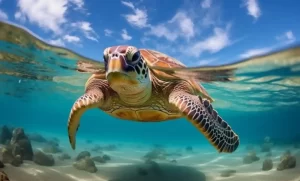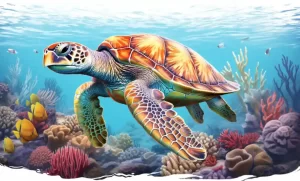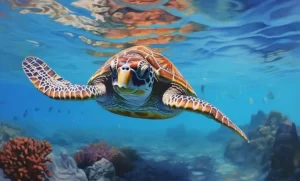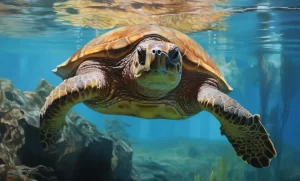
The Loggerhead Sea Turtle, scientifically known as Caretta caretta, is a remarkable marine creature that captures the fascination and hearts of many. With its distinctive large head, strong jaws, and reddish-brown shell, this species stands out in the vast oceanic world. Loggerheads are not just another species in the ocean; they play a crucial role in maintaining the health and balance of marine ecosystems. Their feeding habits help control the population of their prey, contributing to the intricate web of ocean life.
Understanding and protecting Loggerhead Sea Turtles is of paramount importance. These turtles face numerous challenges, from habitat loss to the dangers posed by human activities like fishing and coastal development. The survival of this species is not just about preserving a single creature; it’s about safeguarding the biodiversity of our oceans and ensuring the health of our planet’s marine environments.
Description and Characteristics
The Loggerhead Sea Turtle is a species characterized by some distinct physical features that make it easily identifiable and fascinating to learn about.
Physical Appearance
- Large Head and Strong Jaws: One of the most notable features of the Loggerhead is its large head, which houses powerful jaw muscles. This unique adaptation is not just for show; it serves a critical function. These strong jaws are perfect for crushing and eating hard-shelled prey, such as crabs, clams, and other shellfish.
- Carapace Color and Texture: The carapace, or the top shell of the Loggerhead, is a striking reddish-brown color, providing a beautiful contrast to the often blue or green hues of the ocean. This shell is bony, heart-shaped, and features large, rough scutes (scales) that do not overlap, adding to its distinctive appearance.
- Plastron: The underside of the turtle, known as the plastron, is a lighter yellowish-brown, complementing the darker tones of the carapace.
Size and Weight
- Adult Size: Loggerhead Sea Turtles reach a substantial size as adults. On average, their carapace length, which is the measurement of the shell from head to tail, ranges from about 2.5 to 3.5 feet (80 to 110 cm).
- Weight: When it comes to weight, these turtles are quite hefty. Adult Loggerheads typically weigh between 155 and 375 pounds (70 to 170 kg), showcasing their robust and resilient nature.
Habitat and Diet
The Loggerhead Sea Turtle, with its unique characteristics, has adapted to a specific type of habitat and diet that supports its lifestyle and survival in the ocean.
Natural Habitats
- Coastal Bays and Estuaries: Loggerhead Sea Turtles are often found in coastal bays and estuaries. These areas provide the perfect balance between the calm, shallow waters and the availability of food sources, making them ideal for loggerheads to feed and grow.
- Continental Shelves: In addition to bays and estuaries, Loggerheads also frequent the shallow waters along the continental shelves. These regions of the ocean, which border the continents, are rich in marine life and offer a diverse array of food sources for the turtles. The continental shelves of the Atlantic, Pacific, and Indian Oceans are some of the key areas where Loggerheads are found.
Diet
- Primarily Carnivorous: The Loggerhead Sea Turtle is primarily carnivorous. This means that its diet consists mostly of meat, specifically marine animals.
- Feeding on Shellfish: One of the main components of the Loggerhead’s diet is shellfish. Their strong jaws and powerful biting force make them well-equipped to break open the hard shells of creatures like horseshoe crabs, clams, and mussels. This ability not only provides them with nutrition but also plays a role in controlling the population of these prey species in their natural habitats.
The Loggerhead Sea Turtle’s choice of habitat and diet are closely intertwined with its physical characteristics and behavioral patterns. These elements create a fascinating picture of how the species has evolved and adapted to its environment, showcasing the intricacy and balance of marine ecosystems.
Nesting Habits

The nesting habits of the Loggerhead Sea Turtle are a crucial aspect of their lifecycle, ensuring the continuation of the species. These habits are characterized by specific seasons and patterns that are fascinating to observe and critical for their survival.
Nesting Season and Behavior
- Nesting Season: Loggerheads have a specific season for nesting which typically occurs from April through early September. The peak months for nesting are usually June and July. During this time, female Loggerheads come ashore to lay their eggs, often returning to the beach where they themselves were hatched.
- Nesting Behavior: The process of nesting is quite remarkable. Female Loggerheads will come onto the beach at night, dig a nest in the sand with their flippers, lay their eggs, and then cover the nest before returning to the ocean. This nocturnal behavior helps in reducing the exposure to predators and the hot sun, which could harm the eggs.
Number of Nests Per Season and Eggs Per Nest
- Frequency of Nesting: An individual female Loggerhead does not nest every year. Instead, they typically nest at intervals of 2 to 4 years. When they do nest, they can lay 3 to 6 nests per season.
- Eggs Per Nest: In each nesting event, a Loggerhead can lay an average of between 100 to 126 eggs. These eggs are then incubated naturally by the warmth of the sand, taking about 60 days to develop and hatch.
The nesting habits of Loggerhead Sea Turtles are not just a biological process but a significant event that reflects the delicate balance of marine life. The survival of each new generation of Loggerheads largely depends on these nesting habits, making them a vital aspect of the species’ lifecycle.
Egg Incubation and Hatching
The journey of a Loggerhead Sea Turtle from egg to hatchling is both delicate and crucial. Understanding the incubation and hatching stages gives insight into the early challenges these turtles face.
Incubation Period
- Duration: Once the female Loggerhead lays her eggs, they enter the incubation period. This period typically lasts about 60 days. During this time, the eggs are buried in the sand, relying on the natural warmth of the environment to facilitate the development of the embryos.
- Temperature Sensitivity: It’s interesting to note that the temperature of the sand plays a vital role in determining the sex of the hatchlings. Warmer temperatures generally produce more female turtles, while cooler temperatures result in more males.
Hatching Success Rate and Challenges
- Success Rate: The hatching success rate for Loggerhead eggs can vary. On average, 75-95% of the eggs in a natural nest will hatch successfully. However, numerous factors can influence this rate, including environmental conditions and human activities.
- Challenges for Hatchlings: After hatching, the baby turtles face immediate challenges. Their journey from the nest to the ocean is fraught with dangers, including predators like birds and crabs. Even if they reach the water, young Loggerheads must contend with marine predators. Additionally, human-induced factors like coastal lighting can disorient hatchlings, leading them away from the ocean.
The incubation and hatching stages are critical for the survival of Loggerhead Sea Turtles. Understanding these processes not only highlights the fragility of their early life but also underscores the importance of conservation efforts to protect nesting beaches and reduce human impacts on these crucial stages of a turtle’s life.
Threats to Survival

The Loggerhead Sea Turtle, despite its resilience and adaptations, faces significant threats to its survival. Many of these threats are human-induced, impacting their natural lifecycle and habitat.
Loss of Nesting Habitat Due to Development
- Coastal Development: One of the primary threats to Loggerhead survival is the loss of nesting habitats due to coastal development. As beaches are developed for tourism or residential purposes, the natural nesting grounds of Loggerheads are disturbed or destroyed.
- Impact on Nesting: The loss of suitable nesting beaches makes it difficult for female Loggerheads to find safe places to lay their eggs. This can lead to reduced nesting success or force the turtles to nest in less ideal locations, where the eggs are more vulnerable to predators or environmental factors.
Human Disturbances and Pollution
- Light Pollution: Artificial lighting near beaches can disorient both nesting females and hatchlings, leading them away from the ocean. This misdirection increases the risk of predation and dehydration.
- Pollution: Loggerheads are also affected by various forms of pollution. Plastic and other debris in the ocean can be mistaken for food, leading to ingestion and injury. Chemical pollution can also degrade their habitats and affect the health of both adults and hatchlings.
Incidental Capture in Fishing Activities
- Bycatch: A significant threat to Loggerhead Sea Turtles is bycatch in fishing activities. Turtles can become accidentally caught in fishing gear such as nets and longlines.
- Impact on Population: Incidental capture not only harms individual turtles but can also have a broader impact on the population, especially given the already vulnerable status of Loggerheads.
Addressing these threats is crucial for the conservation of Loggerhead Sea Turtles. Efforts to protect their natural habitats, reduce pollution, and implement turtle-friendly fishing practices are vital steps towards ensuring the survival and flourishing of this species.
Conservation Status
The Loggerhead Sea Turtle’s conservation status is a reflection of the challenges it faces in the wild. Understanding this status helps in guiding conservation efforts and policies.
Current Status on the U.S. Endangered Species Act and IUCN Red List
- U.S. Endangered Species Act: In the United States, the Loggerhead Sea Turtle is listed as ‘Threatened’ under the Endangered Species Act. This designation indicates that the species is likely to become endangered within the foreseeable future, underscoring the need for protective measures and conservation strategies.
- IUCN Red List: Internationally, the Loggerhead is classified as ‘Vulnerable’ on the IUCN Red List. This status is given to species that are facing a high risk of extinction in the wild in the near future. It highlights the global concern for the species and the need for international cooperation in its conservation.
Estimated Population Numbers
- Nesting Females: Estimates suggest that there are between 40,000 and 50,000 nesting female Loggerhead Sea Turtles worldwide. This number is a critical indicator of the species’ overall health and viability, as these females are essential for the continuation of the population.
- Population Trends: Although conservation efforts have led to some positive trends in certain areas, the overall population of Loggerheads continues to face significant pressures. The exact number of Loggerheads globally is challenging to determine due to their wide range and long lifespan.
The conservation status of the Loggerhead Sea Turtle serves as a call to action. It highlights the importance of ongoing conservation efforts, research, and international collaboration to ensure the survival of this species for future generations.
The Role of Human Interaction

Human interaction plays a significant role in the life of Loggerhead Sea Turtles, both positively and negatively. Understanding this relationship is key to shaping our actions and policies to support these magnificent creatures.
Positive Impacts
- Conservation Efforts and Success Stories:
- Various conservation groups and governments have implemented measures to protect Loggerhead habitats, reduce bycatch in fishing, and mitigate other threats.
- Success stories include the recovery of certain nesting beaches and the implementation of turtle-friendly fishing practices in some regions.
- How Individuals Can Help:
- People can contribute to Loggerhead conservation by supporting turtle conservation organizations, participating in beach clean-ups, and adopting responsible behaviors when visiting turtle habitats.
- Educating oneself and others about the importance of Loggerhead conservation and advocating for policies that protect marine environments also make a significant difference.
Negative Impacts
- Human-Induced Threats:
- While some human activities have supported Loggerhead conservation, others have been detrimental. These include coastal development, pollution, and irresponsible fishing practices.
- Understanding these threats is crucial for mitigating their impact and ensuring the survival of the Loggerhead.
- Responsible Tourism and Beach Activities:
- Tourists and beachgoers play a critical role in Loggerhead habitats. Responsible behavior, such as avoiding nesting sites, minimizing light pollution, and not leaving waste on beaches, can significantly reduce human impact.
- Promoting eco-friendly tourism that respects and preserves Loggerhead habitats is essential for their continued survival.
The role of human interaction in the life of Loggerhead Sea Turtles is complex. It encompasses both the challenges we pose to their survival and the actions we can take to protect them. By understanding and actively participating in conservation efforts, we can help ensure that Loggerheads continue to thrive in our oceans.
Conclusion
The Loggerhead Sea Turtle, Caretta caretta, is more than just a species in the vast tapestry of marine life; it is a symbol of the delicate balance and richness of our oceans. Throughout this blog, we’ve explored the unique characteristics, life cycle, and the challenges faced by these majestic creatures. Loggerheads play a critical role in marine ecosystems, helping maintain the health of sea beds and balance the populations of their prey species.
Their journey from hatching on sandy beaches to navigating the vast oceans is a testament to their resilience and adaptability. However, as we’ve seen, Loggerheads face significant threats, primarily from human activities. The loss of nesting habitats, pollution, and the dangers of fishing practices are just a few of the challenges that threaten their existence.
But there is hope. Conservation efforts, both large and small, are making a difference. Protected nesting beaches, changes in fishing practices, and increased public awareness are all contributing to the survival of Loggerheads. Every individual action, whether it’s reducing plastic use, supporting turtle conservation initiatives, or advocating for marine protection policies, adds up to a significant impact.
As we conclude, let’s remember that the fate of the Loggerhead Sea Turtle is intertwined with our own. The health of our oceans reflects the health of our planet, and by protecting Loggerheads, we are also safeguarding our environmental heritage. Let’s be inspired by their journey and commit to actions that ensure these magnificent turtles continue to thrive for generations to come.
Additional Resources
For those interested in learning more about Loggerhead Sea Turtles and how to contribute to their conservation, the following resources offer valuable information and opportunities for involvement:
- Sea Turtle Conservancy: conserveturtles.org
- A leading organization in sea turtle research and conservation, offering extensive information on Loggerhead Sea Turtles and ways to support their conservation.
- World Wildlife Fund (WWF) – Sea Turtle Species: worldwildlife.org/species/sea-turtle
- WWF provides detailed information on different sea turtle species, including Loggerheads, and outlines their global conservation efforts.
- NOAA Fisheries – Loggerhead Turtle: fisheries.noaa.gov/species/loggerhead-turtle
- NOAA Fisheries offers scientific information and conservation status updates on Loggerhead Sea Turtles, with insights into federal conservation efforts and guidelines.
- National Wildlife Federation – Loggerhead Sea Turtle: nwf.org/Educational-Resources/Wildlife-Guide/Reptiles/Loggerhead-Sea-Turtle
- The National Wildlife Federation provides educational resources on Loggerhead Sea Turtles, ideal for learning and teaching about these creatures.
- IUCN Red List of Threatened Species: iucnredlist.org
- The IUCN Red List offers comprehensive information on the conservation status of Loggerhead Sea Turtles, along with detailed assessments of their populations
